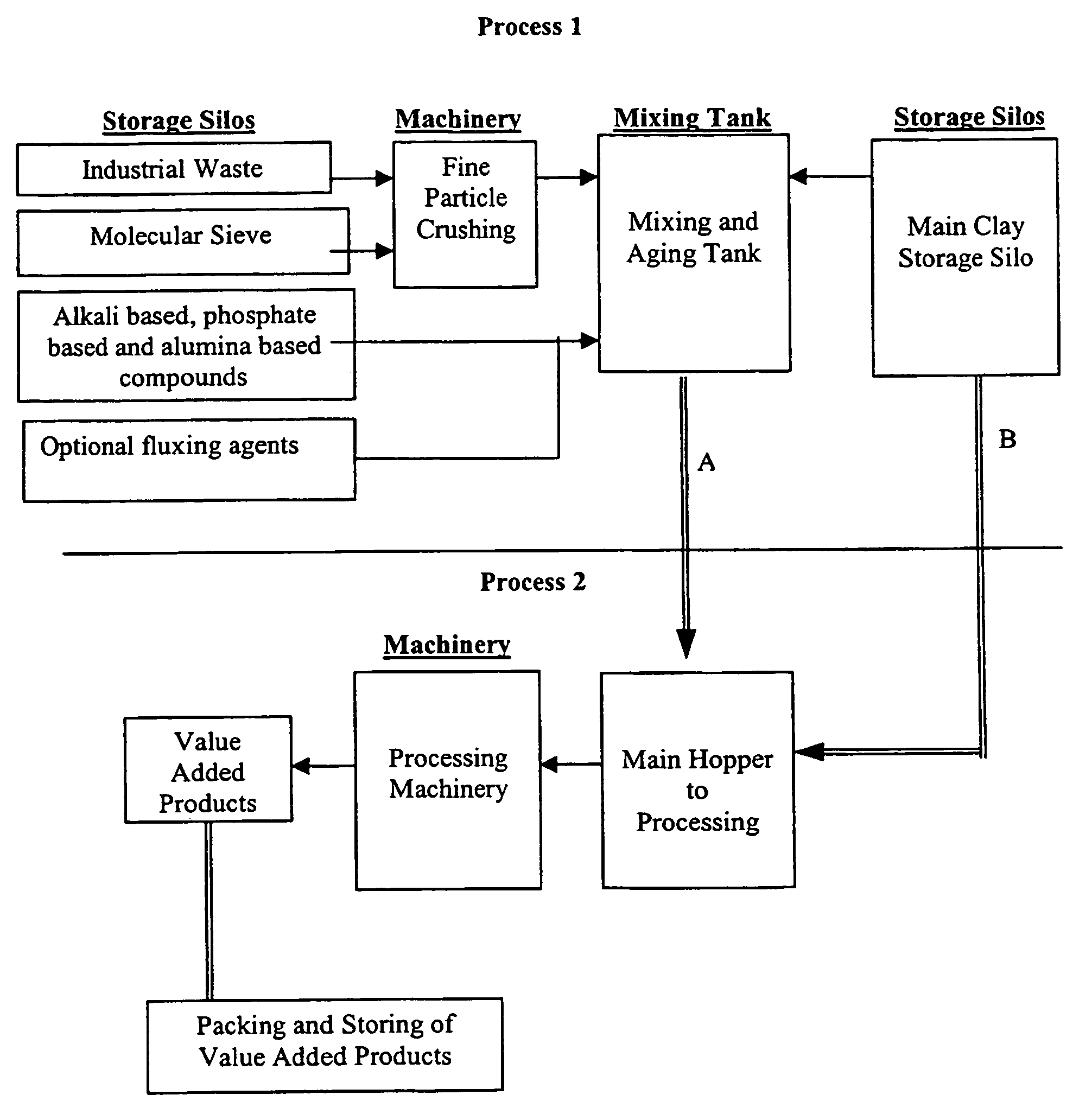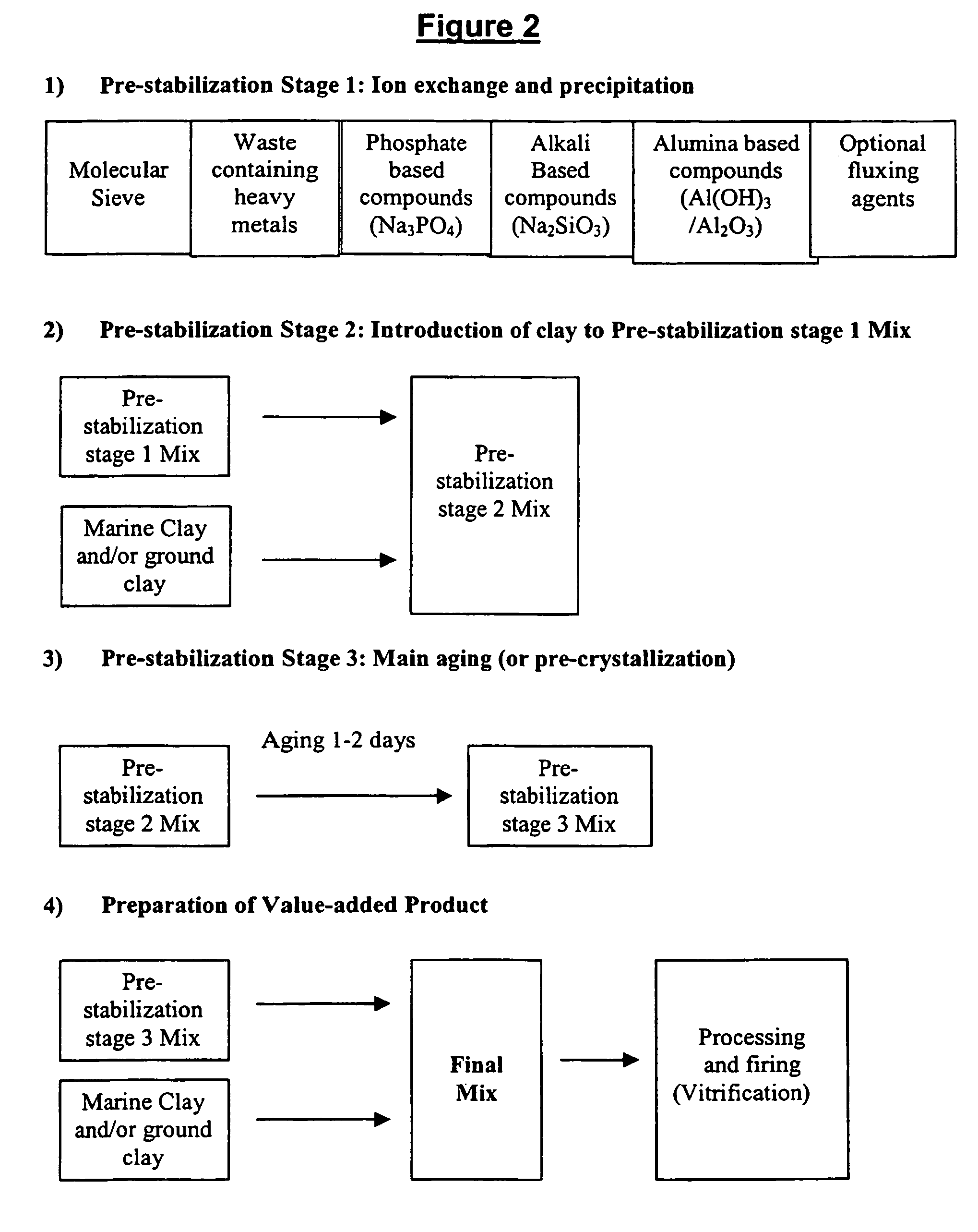Method for waste stabilisation and products obtained therefrom
a technology of waste stabilisation and products, applied in the direction of water contaminants, lighting and heating equipment, bulkheads/piles, etc., can solve the problem of hazardous waste of waste, achieve good metal sorption capability, increase the stability of the end product, and improve the effect of metal sorption ability
- Summary
- Abstract
- Description
- Claims
- Application Information
AI Technical Summary
Benefits of technology
Problems solved by technology
Method used
Image
Examples
example 1
[0176]Seven different types of industrial waste containing heavy metals are selected and treated. The list of selected waste is reported in Table 1.
[0177]The pre-stabilisation of this waste consists of 3 part zeolite and 7 part industrial waste. The industrial waste and zeolite were mixed together in a mixing vessel till slurry. If the natural water content was too low, water was added to the mix till a slurry mixture was obtained.
[0178]The mix was maintained for 4 hours. After which, Na2SiO3 was added to change the pH to 9.0. The pre-stabilised mix was left to age for 8 hours.
[0179]Marine clay was mixed with the pre-stabilised mix in the proportion of 65:35 and the material was processed through a series of mixing and extrusion machines to produce test samples. Water content at this point was maintained at 20% to 25%.
[0180]The samples were dried in a drying oven at 105° C. till the water content reached 0% to 3%.
[0181]The product was fired in the furnace at a predetermined firing p...
example 2
[0199]Partial oxidation carbon, POX carbon from a petrochemical company in Singapore was tested and treated using the technology.
[0200]The pre-stabilization consisted of 2 parts zeolite and 8 parts POX carbon. POX carbon and zeolite were mixed together in the mixing vessel. The water content of the mixture was maintained at 30% to 40%. If the natural water content is too low, water is added to the mix.
[0201]The mix was maintained for 1 hour. After which, Na2SiO3 and Na3PO4 were added in the proportion of 4:1 respectively to change the pH to 9.0. The pre-stabilised mix was aged for 2 hours.
[0202]Marine clay was mixed with the pre-stabilised mix in the proportion of 85:15 and the material was processed by passing it through a series of mixing and extrusion machines. Test samples of 50 mm×12 mm×30 mm dimensions were produced. Water content at this point was maintained at 20% to 25%.
[0203]The samples were dried in a drying oven at 105° C. till the water content reached 0% to 3%.
[0204]Th...
example 3
[0215]The technology was used to treat contaminated marine clay and waste sludge from water works.
[0216]The waste sludge obtained from the water treatment plants was in a cake form. It had a high level of alumina based compounds of roughly 30% in solid form with the remainder 70% water. The 30% solids consisted of mainly Al-based compounds (Al(OH)3), including organic material, bacteria and silica based compounds. Very low levels of heavy metals were detected in the waste sludge. The waste sludge was used as a source of alumina for the stabilisation of heavy metals in this technology.
[0217]The chemical analysis of the synthetic contaminated marine clay is shown in Tables 3 and 4.
[0218]
TABLE 3Analysis of contaminated marine clayConcentration of Heavy Metals (in mg / L)CrMnCuZnAsPbSample428*1154*3534*4937*367*1427*A
[0219]
TABLE 4Trace metal limits for marine clay as allowed in SingaporeConcentration of HeavyMetals (in mg / L)CrMnCuZnAsPbtrace metals50NA551503065limit(Singapore)
[0220]The pr...
PUM
| Property | Measurement | Unit |
|---|---|---|
| temperature | aaaaa | aaaaa |
| temperature | aaaaa | aaaaa |
| pore size | aaaaa | aaaaa |
Abstract
Description
Claims
Application Information
 Login to View More
Login to View More - R&D
- Intellectual Property
- Life Sciences
- Materials
- Tech Scout
- Unparalleled Data Quality
- Higher Quality Content
- 60% Fewer Hallucinations
Browse by: Latest US Patents, China's latest patents, Technical Efficacy Thesaurus, Application Domain, Technology Topic, Popular Technical Reports.
© 2025 PatSnap. All rights reserved.Legal|Privacy policy|Modern Slavery Act Transparency Statement|Sitemap|About US| Contact US: help@patsnap.com



